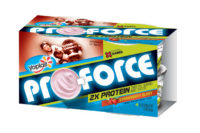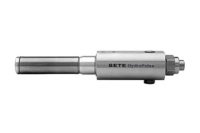
A New Force
by Cathy Sivak
Product launches, positioning and educational efforts rev up probiotic dairy case opportunities.
A probiotics launch
and consumer education campaign from No. 2 U.S. yogurt brand Dannon has
served to propel a veritable race to market.
In Europe and Asia, consumers are long familiar with
the health benefits conferred by live and active probiotic cultures,
including gut health, immune system health and other attributes. The total
international probiotic market in yogurts, kefirs and fermented dairy
beverages translates to $10 billion and growing annual sales.
A decade-long attempt to educate American consumers
about the benefits of probiotics broke loose in 2006 with the introduction
of Dannon Activia® and other probiotic spoonable and drinkable yogurt
products. “Probiotics are a hot topic in the health and wellness
segment of the food industry,” says Guy Bouthillier, director of
business development at Main Street Ingredients, La Crosse, Wis.
Cultures in yogurt and fermented milks are
particularly suitable as live and active probiotic carriers, as they work
together to keep a high count of probiotics viable for the product’s
shelf life. Moving forward, U.S. processors are not only bolstering
probiotic presence in the yogurt and drinks case, but also are considering
probiotics applications in cheeses, frozen desserts and fruit juices.
“Consumers are very interested in the health
benefits that probiotics can provide (i.e. increasing natural defenses,
healthy digestion). The problem for U.S. consumers has always been the idea
of eating bacteria,” says Ralph Koekkoek, product manager of
probiotics at Parsippany, N.J.-based DSM Food Specialties. “Now that
[Dannon parent Groupe] Danone has been able to open up the market for
probiotics and is bringing the message to the U.S. consumers, we see that
other companies are ready to follow.”
In the vernacular, probiotics are friendly bacteria
that help digestive health. The World Health Organization (WHO) defines
probiotics as “live microorganisms which confer a health benefit on
the host when administered in adequate amounts.” The dairy industry
is serving up the shortest definition of all: full-fledged opportunity.
Regulatory Factor
White Plains, N.Y.-based Dannon Co.’s first
probiotic yogurt, Activia, is promoted as a product that aids regularity
and digestive tract health. Sales wildly exceeded expectations, topping
$100 million in 2006. Activia Light, a lower-calorie line extension, is
expected to roll out this year. Dannon has announced it plans to double its
production over the next three years, a move fueled by Activia’s
success.
Activia and other probiotic products tout health
benefits and broach a subject typically discussed behind closed doors or
snickered at by small boys — digestive tract function. Activia
marketing support has landed GI function in the virtual water cooler of the
blogosphere as well as dairy R&D labs nationwide.
The regulatory factor is certainly in play for
Northfield, Ill.-based Kraft Foods’ latest health and wellness
rollout. LiveActive Cottage Cheese under the Breakstone’s and Knudsen
brands supports the digestive system from a different angle: prebiotic
fiber. The non-active, natural fiber aids digestive health and can relieve
bloating, gas and irritability; at the same time, prebiotics act as a food
source for probiotics.
The benefits of the prebiotic fiber inulin contained
in LiveActive are promoted with an on-package tag with the claim,
“Helps naturally regulate the digestive system with prebiotic
fiber,” reports Jason Hecker, Kraft’s brand manager for cottage
cheese. In addition to prebiotic fiber, the 2% LiveActive cottage cheese
product delivers between 11 and 12 grams of protein per 4-ounce serving.
Often classified as dietary fiber, prebiotics
including inulin are utilized in U.S. dairy applications, including some
Stonyfield Farm yogurt products. More than three-quarters of Americans find
it challenging to incorporate more fiber into their diets, according to
Kraft’s consumer research. Since the average American’s fiber
consumption is far short of the recommended 20 to 35 grams of fiber per
day, according to Journal of the American Dietetic Association research,
prebiotics offer new health and wellness opportunities for dairy
processors.
Probiotic Product Action
Possibilities for probiotics carry appeal for brand
and the bottom line managers as well as consumers. “Health benefits
of probiotics fit perfectly into what consumers expect from functional
foods,” says Mirjana Curic-Bawden, senior scientist at Chr. Hansen,
Milwaukee. “Increased R&D activity in the U.S. dairy industry in
recent months will likely result in a range of new product introductions in
2007.”
As part of its “high health” global
product strategy, in 2007 Dannon will introduce DanActive, a probiotic
drink with proprietary L. casei Immunitas, is designed to strengthen the
body’s defenses by enhancing the digestive tract, where 70 percent of
the immune system is located.
Further anticipated offerings are likely to tap into
firmly established global functional food trends and products.
Children are avid yogurt consumers, and processors are
recognizing potential for probiotics. In 2006, Morton Grove, Ill.-based
Lifeway Foods Inc. launched its ProBugs line of drinkable yogurts for kids
ages 2 to 9. Look for Dannon to add to the segment with a reformulation of
its popular kids’ yogurt Danimals in 2007. The drink will contain
multi-functional probiotic Lactobacillus GG to aid in children’s
gastrointestinal function, immune function and maintenance of oral health,
and also removes all artificial colors, flavors and high fructose corn
syrup.
Probiotics Basics
Until mainstream consumers understand the differences
between strains for specific health results and the need to consume
adequate amounts of probiotics daily, the segment may remain a niche
market.
“Unlike other health-related nutrients which can
be processed and formulated in a large array of applications (think omega-3
and calcium), success will be determined by probiotics’ ability to
show noticeable heath improvement,” Bouthillier says. “The
immune system will take some time to be strengthened, and requires daily
doses to remain strong and provide the healthy benefits. Education on the
benefits of probiotics will be essential to the average American
consumer.”
There is a scientific body of evidence pointing to
probiotics efficacies, but in essence, it’s all about the numbers: At
least 100 million live cells per serving is required to deliver a
beneficial effect.
The probiotic strains in U.S. dairy applications
consumers are most familiar in yogurt applications are Lactobacillus, Acidophilus
and L. casei.
Probiotics used in the U.S. food industry typically
belong to one of the following genera and species: Bifidobacterium lactis, Bifidobacteriuim
longum, Lactobacillus acidophilus or Lactobacillus rhamnosus. Probiotic
strains with documented human clinical studies to prove efficacy have
unique alphanumeric strain designations. “Products
made with documented strains have to have a probiotics cell count at least
1 billion per serving or as shown effective in clinical studies,”
Curic-Bawden says.
The most prevalent documented probiotics in U.S. dairy
products include Bifidobacterium lactis, Bifidobacterium lactis BB-12®, Lactobacillus casei, L.casei strain shirota (Yakult), L. rhamnosus LGG® and L.
acidophilus LA-5®.
Each strain carries different functionalities. Most
have documented effects on the balance of microflora in the
gastrointestinal tract and/or the immune system. Clinical documentation
exists for use of probiotics for regulation of intestinal transit,
improvement of status of infant diarrhea and rotavirus, constipation,
traveler’s diarrhea, improved natural defense/immune system and a
positive effect on atopic eczema in infants, Curic-Bawden notes.
Lactobacillus is well known to help to improve food
digestion, nutrient absorption, to stimulate immune system and minimize
pro-cancerous agents in the large intestine. New clinical data is emerging
on Lactobacillus capacity to decrease the mortality incidence in
clostridium bacterium infections (botulism, tetanus and gas gangrene) and
to improve radiology cancer treatment, Bouthillier notes.
Meanwhile, further clinical substantiation is sure to
follow recent observations about Lactobacillus and its impact on
minimizing the symptoms of irritable bowel and other intestinal disorders,
as well as potentially reducing cholesterol levels.
“It often takes years to build the proper
scientific documentation necessary to support credible market
claims,” Curic-Bawden says.
Fermented Functionality
On a global basis, all types of fermented products
supply consumers with probiotics. “Dairy products, including yogurts,
are intrinsically considered healthy, and the presence of live and active
(bacterial) culture in yogurt is well accepted and recognized as a sign of
quality,” Curic-Bawden says.
Consumer acceptance and the combination of what
DMS’ Koekkoek dubs “efficacy and stability in the end
application” are behind yogurt-type products’ leading roles in
the market. Simply put, fermented products are suited to probiotic
stability.
In addition, the need to refrigerate yogurt provides a
good environment to maintain a sufficient level of live and active cells
until the end of 42 to 60 days of shelf life, Curic-Bawden says. However,
survival rates are strain specific and must be tested for each probiotics
strain/dairy matrix.
Fermented dairy products have limitless opportunities
for probiotics applications, according to Curic-Bawden. The short shelf
life of refrigerated fluid milk makes it a good probiotics delivery system.
Flavored milk, in particular, may help mask acidic tone flavor challenges
created by the beneficial bacteria, Bouthillier says.
Further innovations in probiotics are expected in not
only new flavors and fruits, but also in desirable levels of carbohydrates
and added natural sweeteners, Curic-Bawden says. “The trend is
already shifting towards ‘all natural’ and generally more
healthy products,” she says. “Probiotics are in this respect
very flexible; they can be complemented with other health beneficial
ingredients: plant sterols, antioxidants, prebiotics (FOS, GOS) and omega-3
fatty acids.”
One rarely used potential option in yogurt industry is
probiotic treatment with lactase, Curic-Bawden says. “The resulting
yogurt will not only be lactose-free, but also slightly sweeter due to the
residual glucose,” she explains.
Product Potential
While limited data is available on applications of
probiotics in cheese, some varieties are under consideration as potential
probiotic carriers. Delivering the appropriate probiotic dosage in the form
of a cheese stick is one interesting concept for the category, Bouthillier
says.
The biggest cheese challenge is to incorporate
probiotics in sufficient levels per serving without a negative effect on
texture, taste and flavor, Curic-Bawden says. Sterile constraints required
for probiotics incorporation may likewise prove challenging, Bouthillier
adds.
Meanwhile, frozen desserts can be excellent delivery
systems for probiotics, and there is additional potential for frozen soy-
and rice-based products.
Curic-Bawden reports tested strains Bifidobacterium
BB-12 and L. acidophilus LA-5 had excellent survival rates when
tested in ice cream, even after two years of shelf life.
To ensure the daily dose of beneficial probiotics is
provided, the number of frozen strains injected to the mix needs to be more
than 1 billion, Bouthillier says, “but it is feasible.”
Cathy Sivak is a freelance journalist and a former
editor of Dairy Field.
$OMN_arttitle="A New Force";?>
$OMN_artauthor="Cathy Sivak";?>

